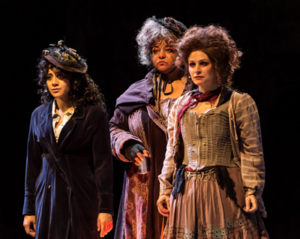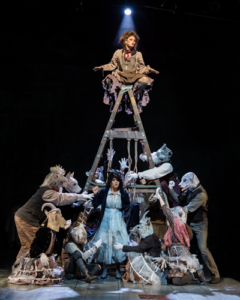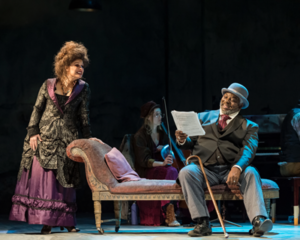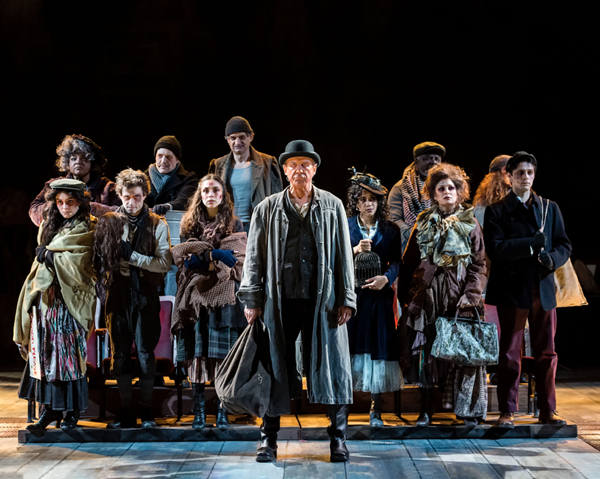By Robert St. Martin
Pasadena, California (The Hollywood Times) 02/20/2024
This weekend was the opening of a new production of Stephen Sondheim’s musical Sweeney Todd: The Demon Barber of Fleet Street at A Noise Within Theatre in Pasadena. Directed by Julia Rodriguez Elliott, the “comic-horror musical” is forty-five years old and originally debuted on Broadway in 1979, with Len Cariou and Angela Lansbury in the lead roles. Sweeney Todd, which many people regard as Sondheim’s finest work, speaks to us differently now, in the twenty-first century, then it did before as an eight-time Tony Award winner. Certainly, the question of “who gets eaten and who gets to eat” feels even more urgent today, as the answer to that question becomes increasingly ruthless. But are there additional ways in which contemporary concerns and awareness might enhance our understanding of Sweeney Todd and allow for a deeper and more nuanced appreciation of Sondheim’s masterpiece?

Sweeney Todd is a fictional character who first appeared as the villain of the “penny dreadful” serial The String of Pearls in 1846-1847. The original tale became a feature of 19th century melodrama and London legend. A barber from Fleet Street, Todd murders his customers with a straight razor and gives their corpses to Mrs. Lovett, his partner in crime, who bakes their flesh into meat pies. The tale has been retold in stage plays and film, as well as the major Broadway production by Stephen Sondheim and Hugh Wheeler.
Tim Burton adapted Sondheim’s musical into his film Sweeney Todd in 2007. It featured Johnny Depp as Sweeney Todd, Helena Bonham Carter as Mrs. Lovett, Alan Rickman as Judge Turpin. The film received two Golden Globe Awards – one for Best Actor in a Comedy or Musical (Johnny Depp), and one for Best Picture, Comedy or Musical. The movie was also nominated for three Academy Awards, winning for Art Direction. Recently Sweeney Todd has been revived on Broadway, with Josh Groban in the lead.

In this new production, the bloodthirsty title role of Sweeney Todd features A Noise Within co-artistic director Geoff Elliott, with resident artists Cassandra Marie Murphy as Mrs. Lovett; Jeremy Rabb as lecherous Judge Turpin; and Kasey Mahaffy as con man Adolfo Pirelli. Also starring are Joanna A. Jones as Turpin’s ward Johanna; James Everts as Johanna’s idealistic suitor, Anthony Hope; Harrison White as the pompous Beadle Bamford; Amber Liekhus as a deranged beggar woman who harbors a dark, surprising secret; and Josey Montana McCoy as the young barber’s apprentice, Tobias.

Geoff Elliott brings his tireless intensity and booming voice to convey Sweeney Todd’s tormented soul, although his singing seems quite pained. The performances by Cassandra Marie Murphy as Mrs. Lovett and Kasey Mahaffy as Adolfo Pirelli with his faux cure for baldness are outstanding. Much of the levity of Sweeney Todd is provided by Murphy’s Mrs. Lovett who from the moment she comically bangs her rolling pin in “The Worst Pies in London.” Murphy, then, takes her versatile talents to another level in Act II’s “By the Sea,” where in a jaunty navy-blue swimsuit and zany red sunglasses, she steals the show in an duet with Elliott’s Todd who, while in a distracted state, is aggressively swung in a rocking chair.
 The staging is quite inspired, and the costumes help to create the characters. Sondheim’s musicals are mostly sung and require skilled voices. This is perhaps the more challenging part of the ANW production by the company’s resident actors, resulting in uneven singing styles (often too much vibrato) and some difficulty with understanding the lyrics. Sondheim’s music is strictly diegetic, so it is part of the narrative being told. The minimalist musical direction by Rod Bagheri with two pianos and a cello on stage helps to draw attention to the lyrics themselves.
The staging is quite inspired, and the costumes help to create the characters. Sondheim’s musicals are mostly sung and require skilled voices. This is perhaps the more challenging part of the ANW production by the company’s resident actors, resulting in uneven singing styles (often too much vibrato) and some difficulty with understanding the lyrics. Sondheim’s music is strictly diegetic, so it is part of the narrative being told. The minimalist musical direction by Rod Bagheri with two pianos and a cello on stage helps to draw attention to the lyrics themselves.
As Director Julia Rodriguez-Elliott has observed, most of the central characters in Sweeney Todd appear to be suffering from some form of mental illness, which in today’s world we would understand as resulting from trauma. In the production at A Noise Within, Rodriguez-Elliott focused not only on the characters’ often troubled psyches, but on the complex intersection of mental illness and homelessness. From sets to costumes to musical arrangements, the production seemed designed with these concerns in mind, resulting in a very different Sweeney Todd from the other productions of the last four decades.

The themes of Sweeney Todd – including social justice, moral corruption, psychological obsession, and trauma cycles – remain highly relevant today, and many of us now bring a more empathic understanding to these topics, which is a positive development. Less encouraging, however, is the fact that too often the prejudices and judgments that the Victorians of Sweeney Todd’s world inflicted upon their less fortunate fellow citizens endure in contemporary attitudes as well. In Victorian England, and in the U.S. today, attitudes towards the poor and especially towards the unhoused – a community in which the incidence of mental illness was and remains high – are depressingly similar.

The opening scene of this production of Sweeney Todd is a play within a play. The story is set in an abandoned theater, where unhoused people are taking shelter. They discover objects and old costumes, and everything takes on this kind of dream-like, almost nightmarish setting. The Industrial Revolution is an unnamed character in this play, a powerful influence that changed the British landscape as well as the global psyche. Tall buildings blocked the sun, new factories belched coal smoke in the first wave of major fossil fuel use that would threaten the planet’s ecosystems a mere century later, and the unprivileged labored in grim workhouses to feed the insatiable machine. One reading of Sweeney Todd is the devouring nature of modern times and that all of humanity meets the mince-meat fate of the demon barber’s unwitting customers. As costume designer Angela Balogh Calin explained it, grittiness and desperation guide the production’s design sense, including the costume concept.

No character in Sweeney Todd embodies the experience of trauma and the consequent mental breakdown more than Sweeney Todd himself. Sweeney returns to London deeply embittered and grief-stricken, though his grief speedily devolves into an obsessively brutal desire for revenge. Sweeney’s deep sense of betrayal, combined with the trauma caused by fifteen harsh years spent as a convict in Australia, render him a completely different person from his former self as Benjamin Barker. Sweeney’s fury and his obsession cross over into insanity in “Epiphany,” for during this song Sweeney speedily descends into the type of full-blown psychopathology that characterizes a serial killer – which, of course, he then becomes.

Other characters in the musical also appear to be suffering the effects of trauma. The Beggar Woman shows clear signs of what today we might identify as a combination of complex PTSD and Dissociative Identity Disorder (evidenced by her swift alterations back and forth between a confused, almost sweet, “pitiful woman what’s got wanderin’ wits” and the hypersexualized, coarse individual who makes aggressively bawdy overtures to young Anthony and Sweeney himself). Even Johanna seems more than a little unhinged in her instantaneous love for Anthony and her willingness to entrust herself to a total stranger. Though Johanna is often played as a classic ingenue, gentle and innocent, her actions arguably reveal her frantic desperation to escape the strict confines of her existence under the control of her twisted guardian Judge Turpin.
Performances of Sweeney Todd take place February 17 through March 17 on Thursdays at 7:30 p.m.; Fridays at 8 p.m.; Saturdays at 2 p.m. and 8 p.m.; and Sundays at 2 p.m. (no 2 p.m. matinee on Saturday, Feb. 17; dark Thursday, Feb. 29). Tickets start at $29. Student tickets start at $18. A Noise Within is located at 3352 E Foothill Blvd., Pasadena, CA 91107. For more information and to purchase tickets, call (626) 356–3100 or go to www.anoisewithin.org.





